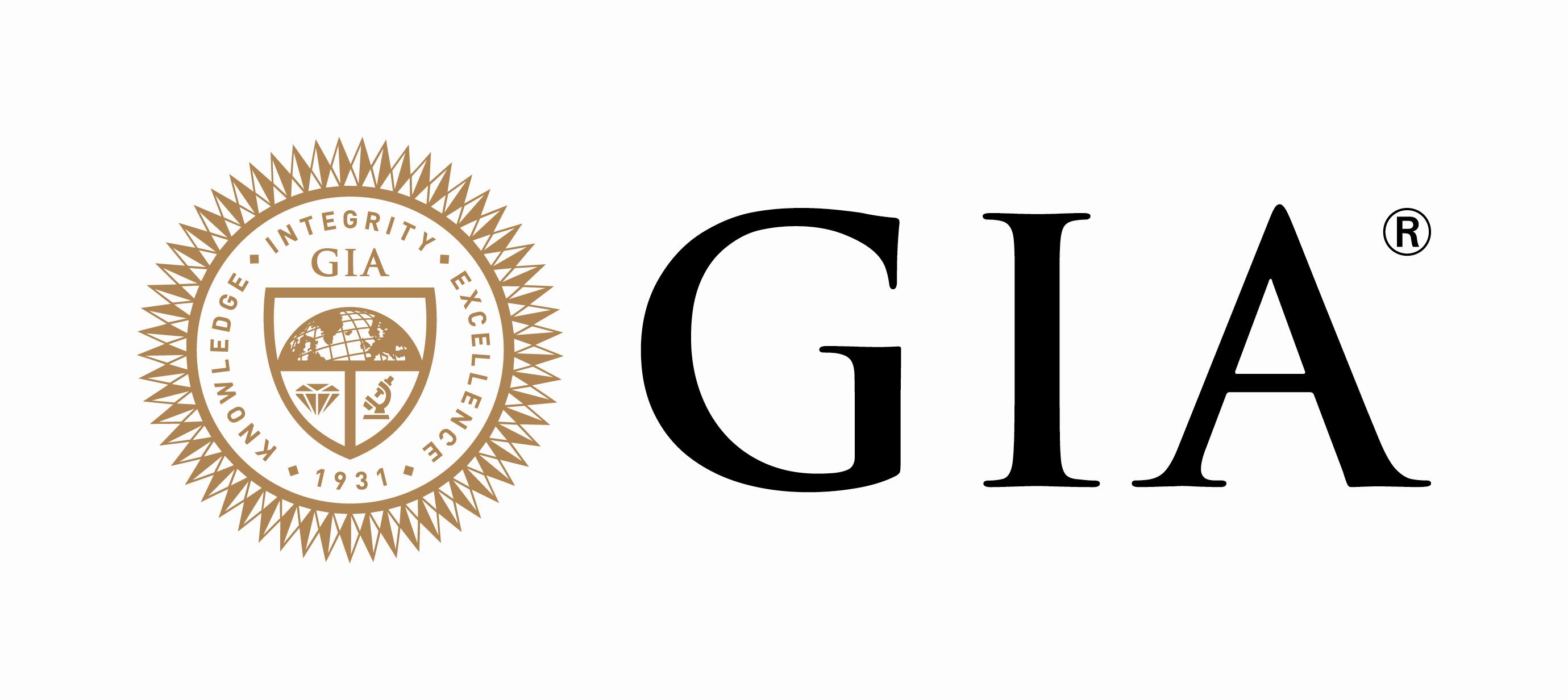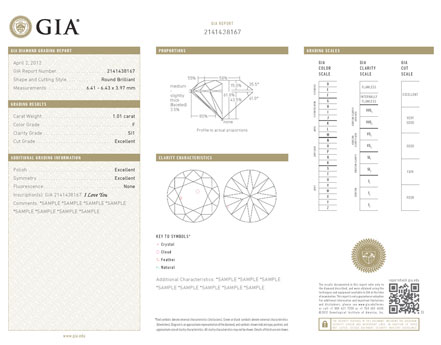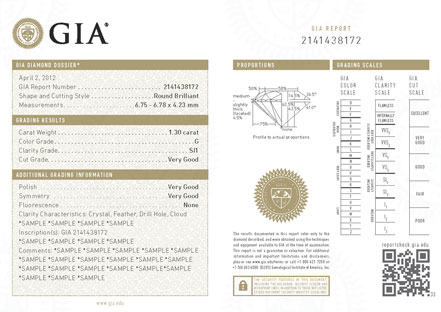The Gemological Institute of America (GIA) is a non-profit organisation founded in 1931. Throughout its history, GIA has been driving innovation in the gem industry. Inventions credited to GIA include the jeweller’s loupe and microscope, the 4Cs, the diamond grading report, and GIA International Diamond Grading System™ including the cut grade for round brilliant diamonds.
GIA has gained the trust of the entire diamond trade serving as the standard against which all other diamond grading labs are compared. Many businesses all over the world rely on GIA to grade and certify diamonds honestly, reliably, and accurately. The success of GIA has led to diamonds being increasingly traded solely based on the GIA certification.
GIA has roots in diamond education, with its founder, Robert M. Shipley, being a prolific educator. The institute runs professional courses including its most reputable Graduate Gemologist program. At the end of the program, graduates are awarded the Graduate Gemologist (G.G.) diploma. GIA is also the publisher of Gems & Gemology, a professional journal that is available quarterly. The first issue of Gems & Gemology was published in 1934, making this its 80th anniversary.
The very profitable non-profit
Being non-profit doesn’t mean GIA doesn’t make a profit, and GIA is actually very profitable. According to the results posted on Guidestar.org, GIA’s annual revenue for 2012 was over $180.3 million and their expenses were around $157.5 million. That leaves a nice profit of about $22.8 million. What non-profit means is simply that there are no owners or shareholders of the institute so GIA has to use all of its earnings towards achieving its goals.
That goal is “…to ensure the public trust in gems and jewelry by upholding the highest standards of integrity, academics, science, and professionalism through education, research, laboratory services, and instrument development.”
However, that doesn’t mean that there are no interested parties at GIA, as there is still a board of governors and executives that run GIA very much like in a company. The current President and CEO of GIA, Susan M. Jacques, began her tenure on Jan 1, 2014. Her predecessor, Donna Baker, who is a lawyer and also has an MBA, is said to have ran GIA like a successful business. Questions have been raised in the past about whether running GIA as a business would endanger its position as a trusted and respected independent lab.
The activities of GIA affect people’s livelihoods and GIA has a responsibility to be unbiased in their diamond grading. Several graders have, in the past, been caught taking payoffs, which ultimately resulted in their dismissal from GIA. In order to maintain the appearance of unbiasedness, GIA has taken steps like cutting down on fund-raising activities, which many industry insiders used to see as a ‘business expense’.
In addition, many diamonds pass through GIA on a daily basis and the turn-around times for grading can affect the supply of diamonds. Currently it takes about 1 to 1.5 months to get a 1ct diamond certified. It can take over 4 months to have sub-1ct diamonds certified outside of the United States. This means that the way GIA is run has a huge influence on the supply, and hence the price of diamonds.
The problem is that GIA has so few competitors in the arena of grading high-quality diamonds that it is effectively a monopoly. AGS and IGI are also well-respected labs, but GIA dominates the market. This makes GIA extremely powerful in the diamond industry. It is in the best interest of consumers to have many more reputable labs that operate on an internationally recognised standard.
This article isn’t meant to bash on GIA. In fact, GIA has benefited almost everyone in the diamond trade. Millions of consumers have also benefited from GIA providing a remarkable level of accuracy in grading diamonds considering the volume of diamonds that are submitted. A world where GIA is a monopoly is certainly preferable to a world without a highly respectable lab. Even today, there is a huge problem of dishonest labs over-grading diamonds.
Diamond Grading Services
GIA’s grading service includes determining whether the material is a natural diamond or a synthetic. Diamonds are also tested for any treatments such as laser drilling, fracture filling, irradiation and high pressure/high temperature (HPHT).
Prior to 2006, GIA’s lab was called the Gem Trade Lab (GTL), a for-profit company that inspects diamonds and other gemstones for a fee and issues a report stating the findings. After 2006, GTL became a part of the non-profit GIA, Inc.
Lab reports dated 2005 or earlier with a title “GIA GEM TRADE LABORATORY” are now outdated as they do not have a cut grade.
Currently there are three types of reports issued by GIA.
- Diamond Grading Report
- Diamond Dossier
- Diamond eReport
GIA Diamond Grading Report
The design of the GIA Diamond Grading Report was updated in 2014. The information has remained the same and it is merely a change in the layout of the report making it easier to read. This report is what most consumers are familiar with and includes information such as the 4Cs, finishing, fluorescence, inscriptions, additional comments, proportions, and clarity characteristics.
It is important to know that a laser inscription of GIA report number is not necessarily included, but is available for an extra charge. This is why it is not unusual for a GIA diamond to not have a laser inscription. The fee schedule for a GIA Diamond Grading Report is based on carat weight and it costs $105 to get a 1ct diamond certified at the time of writing this article. You can download a copy of the full fee schedule here.
GIA Diamond Dossier
The GIA Diamond Dossier is different to the GIA Diamond Grading Report in a few ways. First, it is only available for diamonds in the 0.15ct – 1.99ct range. Also, the cost of the laser inscription is included in the price of the dossier. The most important difference is that the GIA Diamond Dossier does not include a full clarity plot. Rather, the clarity characteristics are stated under additional grading information in the order of their significance.
Typically you will find that vendors opt to purchase the full GIA Diamond Grading Report for diamonds that are 1ct or above. It costs $85 to get a GIA Diamond Dossier for a 1ct diamond but only $53 for a 0.99ct diamond.
GIA Diamond eReport
In 2012, GIA announced that it would be offering a digital lab report that provides GIA grading results online only. The service is available for diamonds in the 0.15ct – 2.99ct range and the reports can be accessed through GIA’s Report Check tool. The GIA Diamond eReport is less expensive than the Diamond Grading Report and includes a high quality photo-micrograph of the diamond. When you mouse-over the image, a window pops up to show you an even higher magnification power like a virtual loupe function. You can see a sample GIA Diamond eReport here.
The eReport is interesting, but it hasn’t taken off because consumers seem to prefer receiving a hard copy of the report and vendors will find it difficult to sell a diamond without a paper-version of the lab report. It’s also not much less expensive, with a GIA Diamond eReport for a 1ct diamond costing $80. The idea of an eReport is also fraught with dangers of potential fraud and raises the risk for consumers. For now, I think it is a good alternative for those who want to get their own diamond certified by GIA and are not looking to resell that diamond.
How GIA grades diamonds
GIA sets the standard for diamond grading so it’s a given that it is considered one of the stricter labs. The carat weight of the diamond is measured using a microbalance with an accuracy of 5 decimal places.
The proportions of the diamond and the angle of the facets are measured using a computerized non-contact optical scanner. Sarin, OGI, and Octonus (Helium) are the three main manufacturers who produce these scanners. For example, using the Helium scanner, the time taken for a scan ranges from 8 seconds to 50 seconds with higher accuracy scans taking longer. The accuracy of these scanners for 0.35 to 18ct diamonds is 0.13 microns, or 0.013mm. GIA reports conservatively with an accuracy of 0.02mm.
Diamond color is graded under GIA DiamondDock™. The DiamondDock provides a consistent lighting environment system for all diamond graders. A diamond is placed face down on a neutral gray tray and is graded against a set of master color-grading diamonds.
The diamond is actually graded twice, by two separate graders. Depending on the agreement of the graders, the carat weight, and the diamond’s value, the diamond will be sent to a more senior grader for review and the process will continue until a consensus on the final color grade is reached.
The clarity of a diamond is graded under 10x magnification. Again, a minimum of two graders will assign their clarity grade, evaluate whether the diamond has undergone any treatments, and draw the inclusions on the clarity plot.
The grader will also give a description of the fluorescence of the diamond. Again, several graders will go through this process in order to arrive at a consensus about the description.
Cut is determined based on the proportions and angles of the facets and are compared against cut tables indicating the potential performance of the diamond, which is visually verified by the grader. A diamond is evaluated based on its brightness, fire, and scintillation. Factors like painting and digging will affect the cut grade as well as the weight ratio of the diamond. Polish, symmetry, and durability will also be factored into the final cut grade.
Why get GIA certification?
If you’ve read my article on diamond grading certificates, you will know that a GIA Diamond Grading Report does not provide sufficient information for you to solely base your purchasing decision on. The report was designed to be easily accessible by all consumers. So why should you get a diamond that is certified by GIA?
Ultimately, a GIA certification is meant to add value to a diamond. From my own experiences, I can tell you that most consumers place a high value on how a diamond is represented on paper. A lab report from GIA will enhance a good diamond but will make a bad diamond less desirable, so it only makes commercial sense that a seller will only invest in the cost of obtaining GIA certification if they think having it makes the diamond easier to sell.
As a consumer, a GIA certification is obviously a good thing. For one, having a diamond with an inscription that matches the GIA report number will give you reassurance that the diamond you purchased matches its description. Also, because a seller at one point in time had to decide whether a diamond should go to GIA or to a lesser lab, a diamond that didn’t go to GIA probably didn’t go for a good reason. The most common reason being that the diamond was predicted to be graded unfavourably according to GIA’s standards.
Finally, because GIA sets the standard on diamond color, clarity, and fluorescence, the only way to guarantee that a diamond meets these standards is if that diamond is certified by GIA. That said, the acceptable tolerance in gemological grading is one grade either way.
Conclusion
From cutting edge research on diamonds to diamond education and consumer awareness, GIA is the benchmark that shapes the diamond industry worldwide. Hopefully this overview of GIA has made clear what GIA is, what they do, and why it is important for you to buy a diamond with GIA certification. Remember that just because your diamond is GIA certified is not a guarantee that it will be a high quality diamond. If you need help evaluating your GIA diamond, feel free to contact me for some free advice.


